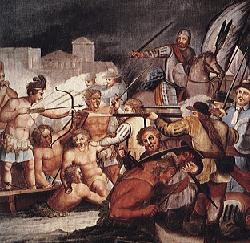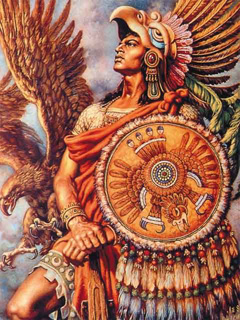
Conquest of the Aztec Empire Part III
The Massacre in the Main Temple
The conquest of the Aztec Empire (also known as Mexica) is filled with sad episodes, that do nothing but show the cruelty and greed of the conquistadors. One such episode was the slaughter of priests, captains and young warriors on a holy celebration, known as the Massacre in the Main Temple. The ceremony was in honour of one of their gods, Huitzilopochtli. The Spanish captain Pedro Alvarado asked for permission to carry it out while Cortez was away.

The men were singing and dancing, completely unarmed. Alvarado ordered his men to block the exits of the sacred courtyard and then the carnage began. The Spaniards attacked with swords and lances. It is said that the blood flowed like a river and that the courtyard was soon filled with dismembered bodies, guts and severed limbs. No-one survived.
The murdered men were highly respected leaders, war veterans, codex interpreters, warlords. They had been educated in Calmécac (the school for the children of nobles). The Aztecs were already incensed by the intensive Spanish presence, but that so far they had not taken action because they of the respect they had for their huey tlatoani. But the Massacre in the Main Temple provoked such levels of indignation that there was nothing to stop them from attacking the foreigners.
They besieged the palace for more than 20 days, were the Spaniards entrenched themselves, taking Montezuma and other chiefs.
Hernán Cortez flees from Tenochtitlan
When Hernán Cortez returned to the capital of the Aztecs he met his fellow soldiers in the Axayácatl palace, which was under constant attack. Cortez had returned with over 3000 soldiers, almost a hundred horses and many more weapons.
Alvarado had kept Montezuma as hostage. In a feeble attempt to bring peace, Cortez asked the tlatoani to climb the palace walls and tried to speak to his people and calm them down. But the Aztecs were incensed and began to throw rocks, one of which hit him and wounded him gravely. He was carried inside, but Montezuma died three days later as result of the wound.
After a long time of coexistence, Montezuma and Cortez had devolved a friendship bond. It is said that the Spaniards were saddened when the tlatoani died. The council of the Aztecs chose a new tlatoani, Cuitláhuac, one of Montezuma's cousins.
Their Spanish situation soon became desperate. Enclosed in the palace, with no food and no water, they had no choice but to flee from Tenochtitlan. They almost didn't make it. 800 Spanish men were killed plus a large number of their allies. They also lost 40 horses, several cannons, and most of the gold they had taken. Not all historians agree, but many say that once they had managed to escape, Cortez wept most of the night, hence why it is called "la noche triste" (the night of sorrows).
The Fall of Tenochtitlan and the Torment of Cuauhtémoc
More than a year passed before the Spanish attempted to take the Aztec capital again. They took refuge with their old allies, the Tlaxcaltecs. After they recovered they fought many battles. Finally Cortez controlled the east, northeast and south of Tenochtitlan, and soon he had the city surrounded. Now they had to coordinate an attack from all entrances to the city, as well as from brigs they had built to attack from the lake.

First the city was cut off from their fresh water supply. The Aztecs tried to stop them, but they lost the fight. Soon they began their attacks, striking simultaneously from the roads, lake and bridges. At first the casualties suffered on both sides were similar.
The Spaniard's strategy was to destroy the bridges connecting the islands to the mainland, in order to make it impossible for the Aztecs to replenish their food and water supplies. The Aztecs' strategy was to rebuild and defend those bridges. They would also send troops to attack the conquerors' headquarters. The siege lasted 93 days. The Spanish course of action took effect.
Meanwhile the Aztecs fed only on roots, drank stagnant water, slept among the dead and refused to surrender. The fall of their empire seemed imminent.
Once Cortez believed the Mexicas were completely weakened they entered the city. The conquistador himself was captured, but was rescued by one of his men, Cristóbal de Guzmán, who himself was taken prisoner, along with other Spanish soldiers. As was the Aztecs' war custom, the prisoners were sacrificed to their gods.
When the siege was over, Pedro de Alvarado took the Tlatelolco square. The Spanish saw that their fellow soldiers had not only been sacrificed and their hearts torn out, but they had also been skinned, and their skin was used to decorate their temples in offering to the god Xipe Tótec. Only 56 Spanish soldiers died, against the 100,000 losses sustained by the Aztecs, who died killed or wounded in battle, or perished from starvation and pestilence.
In the final assault more Spanish lords died, as well as some of the chiefs of the Mexicas. Cuauhtemoc (one of Montezuma's nephews who had been in charge during the night of sorrows and commanded the Mexicas forces during the expulsion of the Spanish from Tenochtitlan) met with some of his captains to discuss their surrender. He left the city in August 13, 1521, allegedly to negotiate his surrender, but he was seen by Captain García Holguín.
When Cuauhtemoc was taken to Cortez, he pointed to the Spaniard's dagger and asked him to kill him, as he had been unable to defend his city and his people, and he would rather die in the hands of the conquerors.
But Cortez did not want to kill Cuauhtemoc and instead restored his noble condition, thinking he could take advantage ofhis tlatoani status. He was treated well, though still a captive, until the Spanish greed took over.
The treasurer ordered Cuauhtemoc's torture, to force him to confess the where the rest of Montezuma's treasure was hidden. His feet were dipped in oil and then putting them close to the fire. Years later, in Spain, Cortez would be found guilty for allowing the torture.
If you would like to know what happened before go to Part I or Part II
